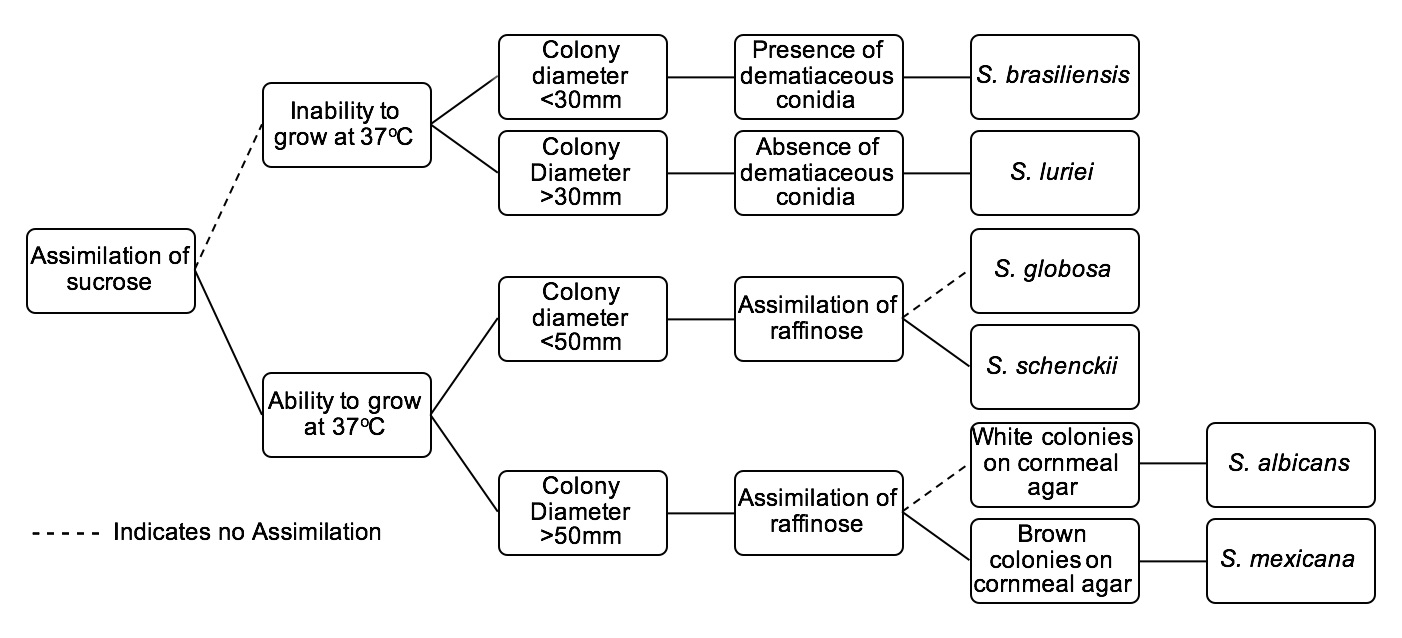Sporotrichosis laboratory findings: Difference between revisions
Jump to navigation
Jump to search
No edit summary |
|||
| Line 14: | Line 14: | ||
===Culture and Identification=== | ===Culture and Identification=== | ||
The gold standard for diagnosis of Sporotrichosis is with fungal culture. The tree below serves as an identification key for six ''Sporothrix'' species of clinical | The gold standard for diagnosis of Sporotrichosis is with fungal culture. The tree below serves as an identification key for six ''Sporothrix'' species of clinical interest: | ||
[[Image:Sporotree.jpg|thumb|none|800px|Identification tree for ''Sporothrix'' species of clinical interest. These clinically significant ''Sporothrix'' species include: ''S. brasiliensis'', ''S. luriei'', ''S. globosa'', ''S. schenckii'', ''S. albicans'', and ''S. mexicana''. When cultivating at 37°C, specimens are to be cultured on Potato Dextrose Agar.<ref name="pmid21976602">{{cite journal| author=Barros MB, de Almeida Paes R, Schubach AO| title=Sporothrix schenckii and Sporotrichosis. | journal=Clin Microbiol Rev | year= 2011 | volume= 24 | issue= 4 | pages= 633-54 | pmid=21976602 | doi=10.1128/CMR.00007-11 | pmc=PMC3194828 | url=http://www.ncbi.nlm.nih.gov/entrez/eutils/elink.fcgi?dbfrom=pubmed&tool=sumsearch.org/cite&retmode=ref&cmd=prlinks&id=21976602 }} </ref> ]] | [[Image:Sporotree.jpg|thumb|none|800px|Identification tree for ''Sporothrix'' species of clinical interest. These clinically significant ''Sporothrix'' species include: ''S. brasiliensis'', ''S. luriei'', ''S. globosa'', ''S. schenckii'', ''S. albicans'', and ''S. mexicana''. When cultivating at 37°C, specimens are to be cultured on Potato Dextrose Agar.<ref name="pmid21976602">{{cite journal| author=Barros MB, de Almeida Paes R, Schubach AO| title=Sporothrix schenckii and Sporotrichosis. | journal=Clin Microbiol Rev | year= 2011 | volume= 24 | issue= 4 | pages= 633-54 | pmid=21976602 | doi=10.1128/CMR.00007-11 | pmc=PMC3194828 | url=http://www.ncbi.nlm.nih.gov/entrez/eutils/elink.fcgi?dbfrom=pubmed&tool=sumsearch.org/cite&retmode=ref&cmd=prlinks&id=21976602 }} </ref> ]] | ||
Revision as of 19:46, 22 January 2016
|
Sporotrichosis Microchapters |
|
Diagnosis |
|---|
|
Treatment |
|
Case Studies |
|
Sporotrichosis laboratory findings On the Web |
|
American Roentgen Ray Society Images of Sporotrichosis laboratory findings |
|
Risk calculators and risk factors for Sporotrichosis laboratory findings |
Editor-In-Chief: C. Michael Gibson, M.S., M.D. [1]; Associate Editor(s)-in-Chief: Alison Leibowitz [2]
Laboratory findings
- Sporotrichosis is a chronic disease with slow progression and often subtle symptoms. It is difficult to diagnose, as many other diseases share similar symptoms and therefore must be ruled out.
- While within human and animal tissues, S. schenckii exists in its yeast form.
- Varying in size and shape, these curved cells typically have 2-6 μm diameters with cigar-like buds offshooting from a narrow base.
- Growing on Sabouraud dextrose agar, most S. schenckii strains become evident after 4 days. At this point, some strains lack dark pigment, while others have been infiltrated with dark pigment from the start. Upon transfer to Brain-Heart Infusion (BHI) agar, and cultured for 7 days at 37°C, the S. schenckii strains undergo dimorphism, manifesting as creamy off-white to beige colored colonies.[1]
- Patients with sporotrichosis will likely have antibodies against the fungus S. schenckii, however, due to variability in sensitivity and specificity, antibody identification may not be a reliable diagnosis for this disease. The confirming diagnosis remains culturing the fungus from the skin, sputum, synovial fluid, and cerebrospinal fluid.
- Cats with sporotrichosis are unique in that the exudate from their lesions may contain numerous organisms. This makes cytological evaluation of exudate a valuable diagnostic tool in this species. Exudate is pyogranulomatous and phagocytic cells may be packed with yeast forms. These are variable in size, but many are cigar-shaped.[2]
Culture and Identification
The gold standard for diagnosis of Sporotrichosis is with fungal culture. The tree below serves as an identification key for six Sporothrix species of clinical interest:

References
- ↑ 1.0 1.1 Barros MB, de Almeida Paes R, Schubach AO (2011). "Sporothrix schenckii and Sporotrichosis". Clin Microbiol Rev. 24 (4): 633–54. doi:10.1128/CMR.00007-11. PMC 3194828. PMID 21976602.
- ↑ Alvarado-Ramírez E, Torres-Rodríguez JM (2007). "In vitro susceptibility of Sporothrix schenckii to six antifungal agents determined using three different methods". Antimicrob Agents Chemother. 51 (7): 2420–3. doi:10.1128/AAC.01176-06. PMC 1913275. PMID 17438048.